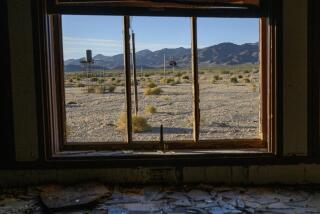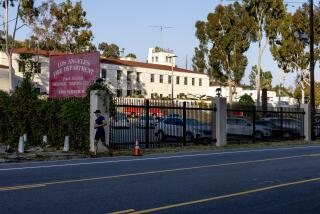Would Study Warner Center’s Effect on Climate : Meterologist Forecasts High--Rises and Heat.
James Vernon was in a reflective mood as he stood outside a mirrored Warner Center office building and shielded his eyes from sunlight that was pounding him from two directions.
“Gradually, we’re developing heat islands here in the West Valley,” Vernon said. “These islands are spreading like amoebas.”
Vernon, a pipe-smoking professor of meteorology at Pierce College, runs a 36-year-old weather station that has continuously plotted climate changes in Woodland Hills as the area has changed from a rural ranch environment to one of the San Fernando Valley’s most urbanized communities.
Vernon’s latest weather forecast: Continued high density and high-rise development in Woodland Hills, to be followed by higher temperatures in that community.
Urges ‘Microclimate’ Study
He thinks it would a “very good idea” if a detailed study of Warner Center’s “microclimate” were conducted.
Such research would take five years, cost about $125,000 and require the cooperation of an institution with many student researchers, such as California State University, Northridge, Vernon said. It would involve as many as 25 small weather monitoring stations scattered around the 1,100-acre Warner Center business and residential area, he added.
The Pierce meteorologist said the study could show the effect that high-rises and huge parking lots are having on temperature and wind patterns. It also could demonstrate the possible “dampening” effect that proper landscaping has on the temperature, he said.
According to Vernon, one square mile of the Warner Center’s mirrored high-rises and parking lots could be elevating temperatures by as much as 4 or 5 degrees for a radius of about half a mile.
Long-Term Benefit Seen
“There could be a long-term benefit for both Warner Center and other areas if it (such a study) produced guidelines for amounts and types of landscaping for urbanized sites,” said Vernon, 62, a one-time Yosemite National Park ranger.
Vernon said that the Pierce College weather station is too far away from Warner Center to measure the effects of high-rise heat. No other measurements have been made closer to the center, he said.
Such statistics would be welcomed by Los Angeles officials who frequently struggle with developers over landscaping requirements for new developments and parking lots, said Al Landini, a city planner who specializes in West Valley land-use matters.
“We require climatic information in environmental impact reports, but sometimes it’s hard to get because of a lack of data,” Landini said. “Statistics would help make the political decisions that have to be made.”
Financing Unlikely
But financing for such a narrowly focused study is unlikely, officials at CSUN and the National Weather Service said.
Warren Bland, chairman of CSUN’s geography department, said the university operates a sophisticated weather station that supplies data to a variety of professional and business users. Grants of more than $5,000 a year for a single research project are few and far between, however, and the $25,000 a year needed to fund Vernon’s idea would likely go begging for funds, Bland said.
Craig Peterson, a National Weather Service meteorologist in Los Angeles, said federally supported weather research now focuses typically on much wider topics.
“The questions in meteorology now are in such things as large-scale global flow. That’s where government grants primarily go now,” Peterson said.
According to Peterson, meteorologists have detected a gradual rise in downtown Los Angeles temperatures because of urbanization, with nighttime low temperatures that are 5 to 10 degrees higher now than they typically were about 40 years ago.
Vernon said such a slow rise in temperature is imperceptible to most people, although it can have a cumulative effect that leads to increased use of air conditioners and more frequent irrigation of lawns. That, in turn, produces more heat and humidity.
More to Read
Sign up for Essential California
The most important California stories and recommendations in your inbox every morning.
You may occasionally receive promotional content from the Los Angeles Times.










